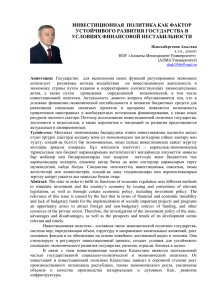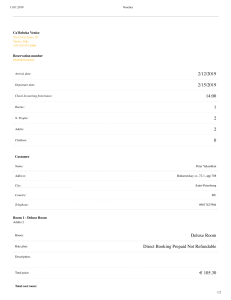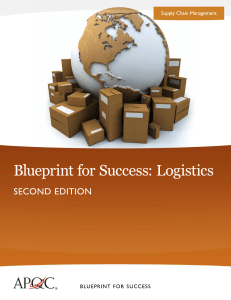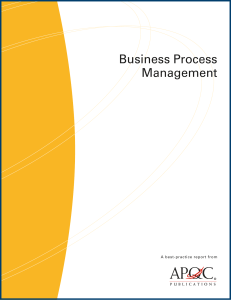
DEL I V E R S E R V I C E S DEF INIT ION S AN D K E Y M E AS U R E S Version 7.2.1 THE FRAMEWORK FOR PROCESS IMPROVEMENT Experience shows that benchmarking’s potential to drive dramatic improvement lies squarely in making out-of-the-box comparisons and searching for insights not typically found within intra-industry paradigms. To enable this type of beneficial benchmarking, the APQC Process Classification FrameworkSM (PCF) serves as a highlevel, industry-neutral enterprise model that allows organizations to see their activities from a cross-industry process viewpoint. The PCF enables organizations to understand their inner workings from a horizontal process perspective, rather than a vertical functional viewpoint. The PCF does not list all processes within a specific organization, and every process listed in the framework is not present in every organization. Originally created in 1992 by APQC and a group of members, the framework has experienced more than twenty years of creative use by thousands of organizations worldwide. The PCF is supported by APQC’s Open Standards Benchmarking research. It is continuously enhanced as APQC’s Open Standards Benchmarking team further develops definitions, processes, and measures. Please visit APQC’s web site periodically for updates. The PCF is available for organizations of all industries and sizes at no charge by visiting www.apqc.org/pcf. HISTORY The Process Classification Framework was originally envisioned as a taxonomy of business processes. The initial design involved more than 80 organizations from the United States and worldwide. Since its inception, the PCF has been updated several times to reflect changes in the way organizations do business. In response to feedback from users of the PCF, APQC regularly engages practitioners, consultants, and academics to develop definitions based on real-world experience with the processes. That collaborative effort resulted in this document: a listing of processes with definitions and selected key performance indicators from APQC’s Open Standards Benchmarking repository. This particular document was developed with assistance from IBM. The definitions contained in this document are to be considered in conjunction with the PCF. The content in this document will be updated according to research performed by APQC and subsequent updates to the PCF. This document was created using PCF version 7.2.1. Version 7.2.1 • November 2019 5.0 Deliver Services OPERATING PROCESSES 1.0 Develop Vision and Strategy >>> >>> >>> 2.0 4.0 3.0 Develop and Deliver Market Manage Products Physical Products and Sell and Services Products and Services 5.0 >>> Deliver Services MANAGEMENT AND SUPPORT PROCESSES 7.0 Develop and Manage Human Capital 8.0 Manage Information Technology 9.0 Manage Financial Resources 10.0 Acquire, Construct, and Manage Assets 11.0 Manage Enterprise Risk, Compliance, Remediation, and Resiliency 12.0 Manage External Relationships 13.0 Develop and Manage Business Capabilities >>> 6.0 Manage Customer Service 5.0 Deliver Services Definitions and Key Measures TABLE OF CONTENTS 5.0 Deliver Services_______________________________ 3 5.2.2 Create and manage resource plan___________6 5.1 Establish service delivery governance and strategies__3 5.1.1 Establish service delivery governance________3 5.2.3 Enable service-delivery resources___________ 6 5.3 Deliver service to customer_____________________8 5.1.2 Develop service delivery strategies__________3 5.3.1 Initiate service delivery____________________ 8 5.2 Manage service delivery resources________________ 5 5.3.2 Execute service delivery___________________9 5.2.1 Manage service delivery resource demand____ 5 5.3.3 Complete service delivery________________ 10 RIGHTS AND PERMISSIONS ABOUT APQC ©2019 APQC. ALL RIGHTS RESERVED. APQC is a member-based nonprofit and one of the world’s leading proponents of knowledge management, benchmarking, and best practices business research. Working with more than 750 organizations worldwide in all industries, APQC provides organizations with the information they need to work smarter, faster, and with confidence. Visit www.apqc.org or call +1-713-681-4020 and learn how to Make Best Practices Your PracticesSM. APQC encourages the wide distribution, discussion, and use of the PCF and PCF definition documents for classifying and defining processes. APQC grants permission for use and adaptation of the PCF for internal use. For external use, APQC grants permission for publication, distribution, and use, provided that proper copyright acknowledgment is made to APQC. No modifications to the look or content should be made in external venues. Please use the following text when reusing the PCF in external print or electronic content. The PCF was developed by APQC and member companies as an open standard to facilitate improvement through process management and benchmarking regardless of industry, size, or geography. The PCF organizes operating and management processes into a number of enterprise-level categories, including categories, process groups, and over 1,000 processes and associated activities. The PCF and its associated measures and benchmarking surveys are available for download and completion at no charge at www.apqc.org. 2 Permission granted to photocopy for personal use. ©2019 APQC. ALL RIGHTS RESERVED. 5.0 Deliver Services (20025) Offering services to customers. This is the act of providing service delivery as a core business practice and covers identifying strategies for performing service delivery, managing resources, and delivering services to the customer. 5.1 Establish service delivery governance and strategies (20026) Creating rules and regulations for service delivery to the customer. Establish a system to manage performance, delivery, and direction of service delivery. Engage with the customer for satisfaction feedback. Define goals, policies, processes, and workplace layout and infrastructure as a part of the service delivery strategy. 5.1.1 Establish service delivery governance (20027) Establishing service delivery governance through a system that manages performance, development, and direction. Allow for customer feedback on delivery satisfaction. 5.1.1.1 Set up and maintain service delivery governance and management system (20028) Providing a system for which to manage customer needs and a structure for which to facilitate service delivery to fulfill those needs. 5.1.1.2 Manage service delivery performance (20029) Conducting and implementing performance measures to ensure successful delivery of service to the customer. 5.1.1.3 Manage service delivery development and direction (20030) Providing guidance of resources to ensure that the development and direction of service delivery is in line with customer needs. 5.1.1.4 Solicit feedback from customer on service delivery satisfaction (20031) Engaging the customer post delivery to gauge the effectiveness of services rendered in order to improve on key delivery functions going forward. 5.1.2 Develop service delivery strategies (20032) Constructing strategies that identify goals, policies, processes, and procedures in relation to service delivery. Review and validate strategies. Define the workplace layout and infrastructure. Version 7.2.1 • November 2019 3 ( 5.1 Establish service delivery governance and strategies continued) 5.1.2.1 Define service delivery goals (20033) Aligning organization practices to meet the needs of the customer by creating service delivery goals. 5.1.2.2 Define labor policies (20034) Outlining labor policies for resources and ensuring that those policies meet the needs of the organization, the customer, and government regulations. 5.1.2.3 Evaluate resource availability (20035) Understanding the needs of the customer and providing the necessary resources to meet those requirements. 5.1.2.4 Define service delivery network and supply constraints (20036) Identifying and understanding the limitations imposed upon service delivery network and supply. 5.1.2.5 Define service delivery process (20037) Definging policies and procedures that focus on meeting the needs and expectations of the customer within the working parameters of the organization. 5.1.2.6 Review and validate service delivery procedures (20038) Revisioning service delivery procedures that fall short of performance parameters. Realign procedures with specified expectations in order to provide successful service delivery. 5.1.2.7 Define service delivery workplace layout and infrastructure (20039) Creating a workplace that best serves the needs of the organization and customer through strategic layout and infrastructure. 4 Permission granted to photocopy for personal use. ©2019 APQC. ALL RIGHTS RESERVED. 5.2 Manage service delivery resources (20040) Understanding the demands on resources and creating a plan to enable the delivery of services via those resources. 5.2.1 Manage service delivery resource demand (20041) Ensuring necessary resources are maintained through monitoring pipeline, developing forecasts, and collaborating with customers. Determine skills needed for service deliver and forecast customer orders. Monitor forecasted orders and modify if where needed. Measure forecast accuracy. 5.2.1.1 Monitor pipeline (20042) Tracking protential oppportunites as they move through the various stages of the pipeline. 5.2.1.2 Develop baseline forecasts (20043) Identifying the demand anticipated for the organization’sservices. Estimate future demand for services using historical data, analysis of the market environment, and external data. 5.2.1.3 Collaborate with customers (20044) Providing a collabrative meeting in which to engage the customer to understand the scope of their needs and constructing solutions based on need and contraints. 5.2.1.4 Develop consensus forecast (20045) Arriving at a consensus over the forecasted levels of demand for services by analyzing baseline forecasts and customer imput. 5.2.1.5 Determine availability of skills to deliver on current and forecast customer orders (20046) Identifying what skillset is necessary for the delivery of opportunites. Determine the forecast of customer orders based upon those skillsets and the resources available. 5.2.1.6 Monitor activity against forecast and revise forecast (20047) Overseeing all activities necessary to deliver services to customer. Revise forecast to account for any issues that may arise. This could be changes in market trend, resource changes, etc. 5.2.1.7 Evaluate and revise forecasting approach (20048) Recognizing potential problems in the current forecast and making the necessary changes to align the forecast meet demand. Version 7.2.1 • November 2019 5 ( 5.2 Manage service delivery resources continued ) 5.2.1.8 Measure forecast accuracy (20049) Analyzing forecasting against actuals to determine accuracy. Modify forecasting to align with actual need. 5.2.2 Create and manage resource plan (20050) Identifying the need for and creating a resource plan. Understand resource demand and align with capacity, skills, and capabilities. Enlist suppliers and partners to supplement needed skills and capabilities. Monitor and manage capabilities and skills with an eye on critical resources and supplier capacity. 5.2.2.1 Define and manage skills taxonomy (20051) Analyzing the skills needed to perform services to be delivered. Classify and organize these skills requirements. 5.2.2.2 Create resource plan (20052) Creating a plan to ensure that all resources are available to carry out services required for the customer. This can include physical resources and personnel. 5.2.2.3 Match resource demand with capacity, skills, and capabilities (20053) Matching demand with skills and capability. Enlisting suppliers and partners to help with demand when needed. 5.2.2.4 Collaborate with suppliers and partners to supplement skills and capabilities (20054) Understanding organizational need to enlist suppliers to provide resources for gaps in skills and capabilities. Identify where additional skills are needed and collaborate with third parties to fill those demands. 5.2.2.5 Identify critical resources and supplier capacity (20055) Realizing critical resources required to perform and carry out customer needs. Engage with suppliers to fulfill those needs, if necessary. Identify supplier threshold for performing those needs. 5.2.2.6 Monitor and manage resource capacity and availability (20056) Directing and managing workforce needs. Ensure that resources are at full capacity. Monitor that all resources are able to skilled in their respective rolls. Make sure that necessary resources are available to provide the needed services. 5.2.3 Enable service-delivery resources (12127) Instituting training to enable resources to provide service delivery to the customer. Develop a training plan. Create materials that provide for operation and technical training. Schedule, perform, and evaluate training. 6 Permission granted to photocopy for personal use. ©2019 APQC. ALL RIGHTS RESERVED. ( 5.2 Manage service delivery resources continued ) 5.2.3.1 Develop service delivery training plan (12128) Creating a detailed summary of all the actions relevant to teaching a person a particular skill or type of behavior. Determine who will deliver the training. Determine when and where the apprentice or trainee needs to go to receive the structured component of the training. 5.2.3.2 Develop training materials (12129) Developing materials necessary to provide comprehensive training for the skills or behavior nedded to deliver services. This can be any number for formats such as classroom or computer based training. 5.2.3.3 Manage training schedule (12131) Provinding training to the employee within a managable timeframe to meet the needs of both the individual and the organization. 5.2.3.4 Deliver operations training (12132) Educating service delivery personnel on all aspects of the operations process of the organization. 5.2.3.5 Deliver technical training (12133) Ensuring that all personnel are trained on all techinical aspects of service delivery. 5.2.3.6 Perform skill and capability testing (20057) Verifying that training provided to the person was succesful through the administration testing and the application of skills for practical use. 5.2.3.7 Evaluate training effectiveness (12135) Eliciting feedback from various sources to evalute the training provided. This can be achieved through testing and the practical application of skills. Additionally, manager or student feedback can be garnered to evaluate training effectiveness. Version 7.2.1 • November 2019 7 5.3 Deliver service to customer (20058) Rendering service to the customer by initiating, executing, and completing tasks associated with service delivery. 5.3.1 Initiate service delivery (20059) Collaborating with the customer to understand service needs. Review, understand, and modify the delivery scope with the organization needs of the customer in mind. Confirm readiness and identify, select, and assign resources. Plan for service delivery. 5.3.1.1 Review contract and agreed terms (20060) Meeting with the customer, partner, and/or supplier to review the terms of the solutions contract and agree on the terms set forth. 5.3.1.2 Understand customer requirements and define refine approach (20061) Taking the customer requirements for a solution and applying those requirements to a refined approach for service. 5.3.1.3 Modify/revise and approve project plan (20062) Updating the project plan to align with the new solution approach agreed upon with the customer. 5.3.1.4 Review customer business objectives (20063) Aligning the customer business objectives with the agreed service delivery solution. 5.3.1.5 Confirm environmental readiness (20064) Confirming that the organization has the recources necessary to meet the expecations for the solution for service delivery. 5.3.1.6 Identify, select, and assign resources (20065) Identifying, selecting, and assigning resources required to deliver service to the customer. Ensure that all objectives are established and met, and the all rules of engagement have been identified and communicated. 5.3.1.6.1 Establish people objectives (20066) Providing the workforce with a plan of action and goals necessary to provide a service. Make sure that those objectives are met. 8 Permission granted to photocopy for personal use. ©2019 APQC. ALL RIGHTS RESERVED. ( 5.3 Deliver service to customer continued) 5.3.1.6.2 Establish engagement rules (20067) Establishing guidelines for how resources engage with the customer. For example, set rules of accountability, interaction, and accommodation when engaging the customer. Resources should be polite, empathetic, and attentive. 5.3.1.7 Plan for service delivery (20068) Establishing a plan of action to suceesfully render a solution for service delivery. 5.3.2 Execute service delivery (20069) Carrying out service delivery to the customer by creating and deploying the necessary solution. Analyze need and create a solution. Validate the solution and make changes if needed. Obtain approval to build/buy solution and then deploy solution to customer. 5.3.2.1 Analyze environment and customer needs (20070) Understanding the needs of the customer and providing the necessary resources to meet those requirements within the scope of the organization. 5.3.2.2 Define solution (20071) Creating a plan of action to provide service delivery to the customer through a possible solution. This solution should be in response to a collabrative effort made by the organization and the customer to meet service delivery needs. 5.3.2.3 Validate solution (20072) Validating that the proposed solution is feasible and provides the needed services for the customer. 5.3.2.4 Identify changes (20073) Realizing issues within the original drafted solution and providing changes to correct those issues. 5.3.2.5 Obtain approval to proceed (20074) Gaining approval from all avenues to proceed with providing solutions for service delivery. 5.3.2.6 Make build/buy solution (20075) Constructing or purchasing solutions necessary to provide service delivery. Version 7.2.1 • November 2019 9 ( 5.3 Deliver service to customer continued) 5.3.2.7 Deploy solution (20076) Providing the customer with promised services and solutions. 5.3.3 Complete service delivery (20077) Implementing final steps to complete service delivery to the customer. Evaluate success through project review, complete finance activities, and confirm delivery. Release resources and manage completion by harvesting knowledge and systems by archiving records. 5.3.3.1 Conduct service delivery/project review and evaluate success (20078) Reviewing the entire service delivery process to evalute the success of the project from beginning to end. 5.3.3.2 Complete/finalize financial management activities (20079) Insuring all payments are received and all activites therein are completed. 5.3.3.3 Confirm delivery according to contract terms (20080) Confirming that the organization has satisfied all terms of the delivery contract set forth in collaboration between the organization and customer. 5.3.3.4 Release resources (20081) Discharging leveraged resources from service delivery commitments upon completion. Returning resources to the resource pool. 5.3.3.5 Manage service delivery completion (20082) Ensuring that all aspects of the service delivery process are completed both internallly and externally. 5.3.3.6 Harvest knowledge (20083) Garnering feedback from all avenues to collect a knowledge base concerning services rendered. 5.3.3.7 Archive records and update systems (20084) Completing and archiving all records associated with requested services. Update all necessary systems to reflect those changes. 10 Permission granted to photocopy for personal use. ©2019 APQC. ALL RIGHTS RESERVED. 123 North Post Oak Lane, Third Floor Houston, Texas 77024-7797 800-776-9676 phone • +1-713-681-4020 • +1-713-681-8578 fax pcf_feedback@apqc.org • www.apqc.org Version 7.2.1 • November 2019 11







